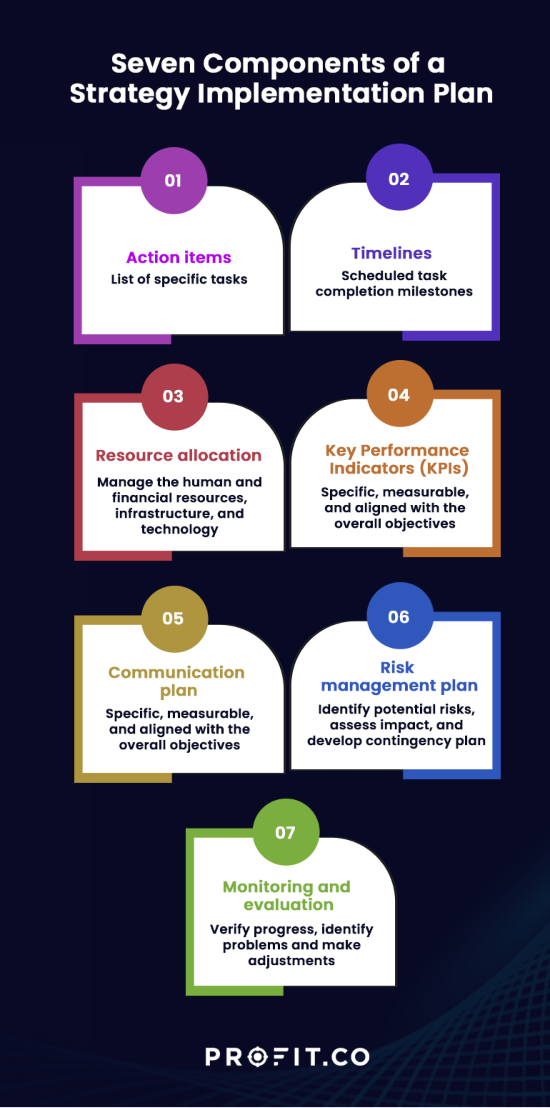A strategy implementation plan is crucial for businesses to effectively execute their strategy by breaking it down into specific tasks, assigning responsibilities, establishing timelines, and tracking progress. A strategy implementation plan is a detailed roadmap that clearly defines the steps and activities required to execute the strategy effectively.
Content Index
Key Highlights
- The success of a business depends on how good its strategy is, but a great strategy is still just a concept or blueprint that merely reflects the intent of the business.
- A strategy implementation plan is a detailed roadmap that clearly defines the steps and activities required to execute the strategy effectively.
- While a strategic plan focuses on defining the strategy, a strategy implementation plan focuses on executing it.
- A strategy implementation plan is crucial for turning a strategic plan into reality as it outlines all the steps and actions required to implement a strategy.
- A well-designed strategy implementation plan helps businesses ensure the effective allocation of resources, alignment, and cooperation of all the stakeholders in working towards the same goals and progress in the right direction.
- Following are some of the key components in a strategy implementation plan necessary for successfully executing a strategy: Action Items, Timelines, Resource Allocation, Key Performance Indicators (KPIs), Communication Plan, Risk Management Plan, and Monitoring and Evaluation.
Strategy and Implementation Plan
The success of a business depends on how good its strategy is. A solid business strategy helps the business organization achieve its objectives, remain competitive, and stay ahead of the competition. It takes into account various aspects of the business, such as its strengths, weaknesses, opportunities, and threats, and enables businesses to create a well-defined plan to cater to the customers with suitable offerings and weather the challenges in the market. It enables businesses to set clear goals, identify the steps needed to achieve them, and determine the resources required for success.
However, a great strategy is still just a concept or blueprint that merely reflects the intent of the business. Unless you manage to implement it effectively, a strategy cannot achieve the desired outcomes. Strategy implementation provides a clear direction for achieving the strategic objectives and ensures success. A perfect strategy implementation requires a focused and coordinated effort across all levels of the organization. It involves putting the right people, processes, and resources in place to execute the strategy effectively. It calls for a detailed strategy implementation plan.
What is a Strategy Implementation Plan?
A strategy implementation plan is a detailed roadmap that clearly defines the steps and activities required to execute the strategy effectively. It provides businesses with a framework for setting priorities, managing resources, and tracking progress toward achieving the desired strategic objectives. A well-crafted implementation plan enables businesses to execute the strategy in the most efficient and effective manner possible, increasing their chances of success.
Our goals can only be reached through a vehicle of a plan. There is no other route to success.
What is the Difference Between a Strategic Plan and a Strategy Implementation Plan?
A strategy implementation plan is a totally different document compared to a strategic plan. They both serve different purposes.
A strategic plan is devised by the top management. It is a high-level document that focuses on the bigger picture and the ambitions of an organization. It outlines the vision, mission, and long-term goals of the organization. It elaborates on the direction the organization wants to take and the long-term objectives it expects to achieve over a certain period, usually three to five years. A strategic plan details the overall strategy and lays out a roadmap for how the organization will achieve its goals.
In contrast, an implementation plan is a highly detailed, actionable, tactical document that lists and details the specific actions and steps businesses should take to implement a strategy. It breaks down the business strategy into specific tasks and smaller objectives. It assigns responsibilities to relevant team members, establishes timelines and milestones for each task, event, and activity, and provides a framework for tracking progress and evaluating success.
While a strategic plan focuses on defining the strategy, a strategy implementation plan focuses on executing it. A strategy implementation plan is critical for translating the strategy into action and making progress toward achieving the strategic goals.
| Components | Strategic Plan | Strategy Implementation Plan |
|---|---|---|
| Purpose | To determine the direction, priorities, and goals of an organization | To provide a detailed roadmap for implementing the strategic plan and achieving the goals and objectives outlined in it |
| Scope | Overarching, high-level plan and statement of intent regarding where the organization wants to go | Comprehensive action plan for how the organization will achieve its strategic objectives and what activities and steps it will need to take to achieve them |
| Timeframe | Typically covers a longer period (3-5 years) | Focuses on a shorter time frame (1 year or less) |
| Key Elements | Vision statement, mission statement, SWOT analysis, market analysis, goals, and objectives | Includes specific action steps, timelines, resources, responsible parties, and metrics for success |
| Audience | Primarily intended for internal stakeholders, such as executives and board members | Primarily intended for those responsible for carrying out the plan, such as department heads |
| Flexibility | Flexible, changeable, and adaptable as circumstances change over time | Usually less flexible, as it provides a more detailed and specific roadmap for implementation. Changing it might require completely canceling/re-planning everything from scratch as opposed to minor adjustments based on periodic review |
Why is a Strategy Implementation Plan Important?
A strategy implementation plan is crucial for turning a strategic plan into reality as it outlines all the steps and actions required to implement a strategy. It helps organizations to effectively execute their strategy by breaking it down into specific tasks, assigning responsibilities to the right people, establishing timelines for each task and milestone, and providing a framework for tracking progress and evaluating success.
Without a strategy implementation plan, a strategic plan may remain nothing more than just an idea, with no clear path to execution. A well-designed strategy implementation plan helps businesses ensure the effective allocation of resources, alignment, and cooperation of all the stakeholders in working towards the same goals and progress in the right direction.
A strategy implementation plan also helps businesses identify potential obstacles and challenges, allowing businesses to proactively put mitigation strategies and counteracting mechanisms in place to address them before they grow into bigger issues. It also helps to establish accountability by assigning responsibilities to the team members for specific tasks, outcomes, and deliverables.
Learn more about achieving continuous learning through OKRs from Profit.co today
Seven ways an effective strategy implementation plan can help execution.
- Helps to convert a strategic plan at a conceptual level into actionable steps, activities, and tasks.
- Assigns responsibility for every task to concerned personnel, creates a reporting structure, and ensures accountability.
- Establishes timelines and milestones and makes tasks and steps time-bound and trackable.
- Provides a framework for measuring progress towards the objectives and evaluating success.
- Ensures judicious allocation of adequate resources for all the tasks and steps.
- Identifies potential obstacles or challenges and proactively addresses them.
- Helps organizations achieve their strategic objectives and realize their vision.

Seven Components of a strategy implementation plan
Following are some of the key components in a strategy implementation plan necessary for successfully executing a strategy.
1. Action items
Action items are a list of specific tasks that the company needs to complete to implement the strategy. Each action item is clearly defined, with instructions, expected outcomes, deadlines, and resources needed. Every action item should be assigned to a specific individual or team with clear expectations and accountability. Following are some examples of action items.
Examples
- Develop a landing page to generate leads.
- Hire a social media manager and a content director to execute the marketing strategy.
- Train the staff on leveraging AI to gain more comprehensive insights from the collected data.
- Secure funding for the marketing initiatives to promote the newly launched product line.
- Create a new e-commerce store to support the strategy.
2. Timelines
Every task, action, or step requires a timeline to determine when it needs to be completed and by whom. The timeline should also be segmented into smaller time frames, and the expected progress at those specific points during strategy implementation should be listed as key milestones and deadlines. It is important to ensure that the timeline is realistic and achievable. While creating the timeline, you should also take into account any potential delays or unexpected roadblocks that may arise during the strategy execution.
Examples
- Lead generation
- 1000 leads by the 30 April 2023
- 2500 new leads by 31 May 2023
- 4000 new leads by 30 June 2023
- Hire new employees
- Write job descriptions with detailed roles and responsibilities – 20 Apr 2023
- Add them to the list of openings on the ‘Career’ page on the corporate website – 27 Apr 2023
- Communicate the requirements and invite applications through digital ads and Manpower site listings – 30 Apr 2023
- Shortlist suitable candidates and schedule interviews – 15 May 2023
- Assess the findings and select the right employees – 25 May 2023
- Communicate with them and confirm their availability and willingness to join – 26 May 2023
- Send offer letters to them – 31 May 2023
- Onboard the new employees with an induction – 30 June 2023
Responsibility: Marketing Manager
Action item: Achieve 4000 new leads by the end of Q2
Responsibility: Marketing Manager
Steps and Timeline:
Responsibility: HR Manager
Action item: Hire a social media manager and a content director in Q2
Steps and Timeline:
3. Resource allocation
The strategy implementation plan should mention the resources needed to implement the strategy, including human resources, financial resources, equipment, infrastructure, and technology. The strategy implementation plan must ensure the allocation and availability of necessary resources for all the tasks at the appropriate times throughout the implementation process.
Examples
Budget
- Q2 Marketing campaign – $100,000
- Recruitment and onboarding of new employees – $50,000 for new employees
- Technology training and upskilling employees – $25000
- E-commerce Website and landing page development – $100,000
Personnel: Marketing team, Accounts team, HR team, IT team, and third-party consultants
Equipment: New computers and software for staff, marketing materials, new multi-channel campaign management software, and website hosting
4. Key Performance Indicators (KPIs)
Strategy implementation requires careful monitoring and tracking of the progress toward the objectives. For that, you should identify the relevant Key Performance Indicators (KPIs) and key metrics to measure the success of the strategy implementation. These KPIs should be specific, measurable, and aligned with the overall objectives of the strategy. The plan should have target numbers to verify that the action items lead to desired outcomes.
Examples
- Increase sales by 15%.
- Achieve an increase in website traffic by 20%.
- Increase customer satisfaction by 10%.
- Boost social media engagement by 25%.
5. Communication plan
Strategy execution requires communication with various stakeholders at various points in time. So you need a communication plan to govern all the communication involved in strategy execution. It should inform all stakeholders about the strategy execution, including the goals, timelines, and progress updates. It should also describe the appropriate channels and frequency of communication throughout the implementation to continuously engage with the stakeholders.
Examples
- Monthly progress updates to all employees
- Quarterly progress reports to the executive team and board of directors
- Fortnightly newsletters to customers
- Social media updates thrice a week
6. Risk management plan
When a company is planning a strategic implementation, it must consider the risks involved in it and the challenges and problems that may arise during the implementation. So there is a need for a robust risk management plan to identify potential risks, assess their likelihood and impact, and develop strategies for mitigating them. It should also include a contingency plan as a backup in case of unexpected events. Planning should also include mechanisms to regularly monitor and address the risks throughout the implementation process.
Examples
-
Potential risk: Failure of the marketing campaign
Mitigation strategy: Conduct thorough market research and set up focus groups to test the campaign before launch.
-
Potential risk: Lack of adoption of a new technology
Mitigation strategy: Set goals for the company-wide adoption of the new technology using the OKR framework and set a deadline. Communicate it with the employees, update adoption data regularly on the OKR software, collect regular feedback through and provide training and support for staff to ensure successful adoption.
-
Potential risk: Lack of financial resources
Mitigation strategy: Develop a contingency plan to secure additional funding if necessary.
7. Monitoring and evaluation
It is imperative to monitor and evaluate strategy execution regularly to verify progress, identify problems, make adjustments, and ensure that the strategy execution is on track. The monitoring and evaluation process should be ongoing throughout the period of strategy implementation. So the strategy implementation plan should include a process for collecting and analyzing data. It should also mention the means to report progress to stakeholders.
Examples
- Regular review of sales data to track progress toward KPIs
- Comparing the number of leads generated with the sales conversion figures to identify the ratio of quality leads
- Analysis of website traffic, number of leads generated, and social media engagement
- Monthly surveys to measure customer satisfaction
- Quarterly review of the budget to ensure proper allocation and utilization of resources
Strategy Implementation Plan: Frequently Asked Questions
1. What is a strategy implementation plan?
A strategy implementation plan is a detailed roadmap that clearly defines the steps and activities required to execute the strategy effectively. It provides businesses a framework for setting priorities, managing resources, and tracking progress toward achieving the desired strategic objectives. A well-crafted implementation plan enables businesses to execute the strategy in the most efficient and effective manner possible, increasing their chances of success.
2. What are the 5 steps of strategy implementation?
The five steps of strategic implementation include
- Strategic Planning
- Communicating the strategy
- Aligning the organization
- Strategy implementation
- Monitoring and adapting
3. How do you write a strategy implementation plan?
- Define specific goals and objectives.
- Identify the tactics and initiatives needed to achieve those goals.
- Ensure alignment with the strategic objectives.
- Develop a timeline and budget for each initiative.
- Assign responsibilities and establish performance metrics.
- Assess risks and create a risk management plan.
- Create a communication plan to communicate with stakeholders.
- Continuously monitor progress and adjust the plan as needed.
Strategy implementation plan: Key takeaways
- A great strategy is just a concept without a solid implementation plan.
- A strategy implementation plan helps businesses turn their strategy into reality by breaking it down into specific tasks, assigning responsibilities, establishing timelines, and tracking progress.
- A strategy implementation plan differs from a strategic plan, which focuses on defining the strategy and long-term goals.
- Key components of a strategy implementation plan include action items, timelines, resource allocation, KPIs, communication plan, risk management plan, and monitoring and evaluation.
Conclusion
In recent years, the latest trends in strategy implementation have focused on agility, innovation, and digital transformation. Companies invest in technology to optimize processes, create cross-functional teams for collaborative decision-making, and prioritize customer-centricity.
Bridge the Strategy Execution Gap with Profit.co

